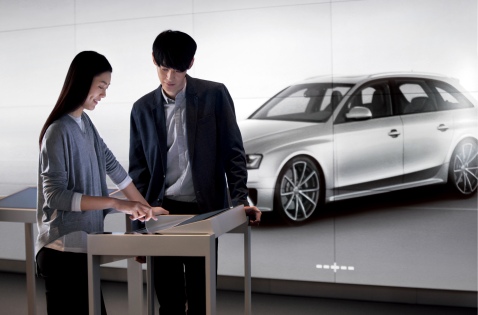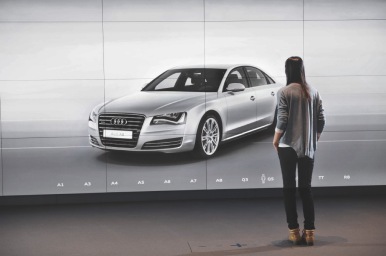When it comes to exploring the technology landscape to discover what 3D Product Configurators are out there, why not start with the cream of the crop, Audi City.
This is 3D Product Configuration done properly. It’s the gold standard of what can be achieved when you push today’s technologies to the limit (watch video).
Audi spent around 2 years developing a state-of-the-art digital cyberstore to bring the showroom experience to city dwellers. After a successful London launch in July 2012, carefully targeted around the Olympic Games for maximum exposure, Audi has opened 2 additional stores, one in Beijing (January 2013), another in Berlin (February 2014) and a forth is planned for Moscow this year.
The cyberstore’s are comprised of giant digital screens known as “Power Walls”. With the help of 32in multitouch displays, you can select any Audi model in their entire range and view the full 1:1 scale, 3D photo-realistic vehicle, in all it’s digital glory. If you prefer to get physical, you can alternatively navigate the options by walking in front of the wall, and letting the Kinect camera’s sense your motions.
Visualising the life-size 3D cars replaces the need for large, expensive showrooms full of vehicles, but this is just the beginning of what the technology has to offer. Using the touch screen and motion sensors, you can explore every detail of any model by rotating and zooming in on the car as if the real thing existed in it’s true physical form. The magic really happens when you decide to customise the Audi by choosing which colours, parts and accessories make up your perfect car, and watching as the virtual representation changes in real-time. Every possible combination of all the options are too numerous to display in any showroom, so this is where Audi has made the impossible, possible.

Here is a great video from Audi’s technical lead Amit Sood, demonstrating the design.
So, is there value in interactive 3D product visualisation and customisation? Audi City answers that question with a resounding “yes”. The multiple technologies and integration not only add tremendous value to the customer experience, but it also allows Audi to cut costs in new innovative ways and increase their customer exposure to the urban population. This is proven by the fact that Audi’s flagship London store’s sales are up 70% since opening, and Audi plan on having 20 of these cyberstores open by 2015.
In it’s entirety, there are many layers of design and technical excellence, with much of it hidden behind the curtains to keep the complexity invisible to the customer. We are not just talking about the achievement of creating a realistic full sized vehicle to view, but the entire end-to-end customer purchasing process has been accommodated. They have precisely analysed the stages a buyer goes through when choosing their perfect car and have re-invented it with a tantalisingly slick flow, which leaves the customer with an elite feeling of being part of the future.
A full analysis of every aspect of the design is another post in itself, so this is more of an overview to introduce the concept of what’s possible, and to get the design juices flowing. It is however, worth highlighting some of the main areas of design that have been incorporated and linked together seamlessly. This is not an exhaustive list but it illustrates the inter-dependence of multiple systems and technologies.
Here’s an overview of some key areas of design:
- The vehicle 3D visualisation, including materials, lighting, animation, sounds and real-time rendering
- The touch screen user interface to select cars and customise parts, colours and materials
- The flow of stepping through each stage of customisation process, from choosing the car model, to selecting exterior and interior features
- The Power Wall display and links to the touch screen device and body motion sensors for interaction
- Linking in to Audi’s Internet configurator, so you can continue to customise at home
- Full integration to the back-end ordering system, including updating the price as you choose options, and highlighting any additional accessories that may be required
- The ability to sample real physical materials to help picture the final product

This is a wonderfully bold step by Audi, and to commit to 20 stores by 2015 shows that they have a solid design that they are confident about replicating. They have invented a successful recipe they can re-use, and since it is software based, a good portion of the user experience can be upgraded over time as they find better ways of taking the customer on the journey towards their perfect car.
As Audi stands for innovation, the most recent cyberstore in Berlin allows customers to view their ideal Audi in Stereo 3D. What will Moscow bring? I look forward to seeing how each store evolves and how long it will be before we are using virtual reality at home, to customise and drive our perfect Audi without even leaving the couch.
Further reading
Driving the future of car sales
The high-tech cyberstore that could be the future of buying cars
Audi launches world’s first Kinect-powered car dealership in London
Audi City Virtual Showroom Expands
Audi to add 16 virtual showrooms in 2014
Audi, BMW, Mercedes look for edge with virtual showrooms



